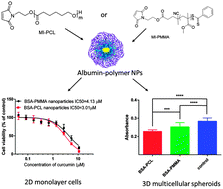Albumin–polymer conjugate nanoparticles and their interactions with prostate cancer cells in 2D and 3D culture: comparison between PMMA and PCL†
Abstract
Using proteins as the hydrophilic moiety can dramatically improve the biodegradability and biocompatibility of self-assembled amphiphilic nanoparticles in the field of nanomedicine. In this study, we fabricated and evaluated curcumin loaded albumin–polycaprolactone nanoparticles as a novel drug delivery system for prostate carcinoma therapeutics and compared their performance to poly(methyl methacrylate) (PMMA), a non-degradable and amorphous polymer. The maleimide functionalized poly(ε-caprolactone) (PCL) was obtain using ring opening polymerization (ROP) of ε-caprolactone where N-(2-hydroxyethyl)maleimide was used as an initiator. The resorbable albumin–polymer conjugate was prepared by conjugating the hydrophobic maleimide-terminated PCL to the hydrophilic bovine serum albumin (BSA) via a simple Michael addition reaction. PMMA was conjugated in a similar manner. The amphiphilic BSA–polymer conjugates can self-assemble into nanoparticles, displaying well-defined structure, prolonged storage stability, and excellent biocompatibility. The BSA nanoparticles, with encapsulated curcumin, exhibited highly enhanced antitumor activity compared to free curcumin. Furthermore, the high efficacy of the curcumin loaded nanoparticles was verified by effectively inhibiting the growth of three-dimensional LNCaP multicellular tumour spheroids. The cytotoxicity was attributed to the efficient cellular uptake of the nanoparticles through caveolic endocytosis. The direct comparison between PCL and the PMMA revealed that drug loading and release as well as cytotoxicity is not significantly affected by the nature of the polymer. However, it seems that nanoparticles based on PMMA penetrate quicker into LNCaP multicellular tumour spheroids thanks to the increased stability. The faster penetration was found to reduce the toxicity of the nanoparticles as evidenced by the lower number of dead cells. In contrast, the fully degradable PCL-based nanoparticles were more efficient in delivering the drug, thus limiting the growth of LNCaP multicellular tumour spheroids.


 Please wait while we load your content...
Please wait while we load your content...